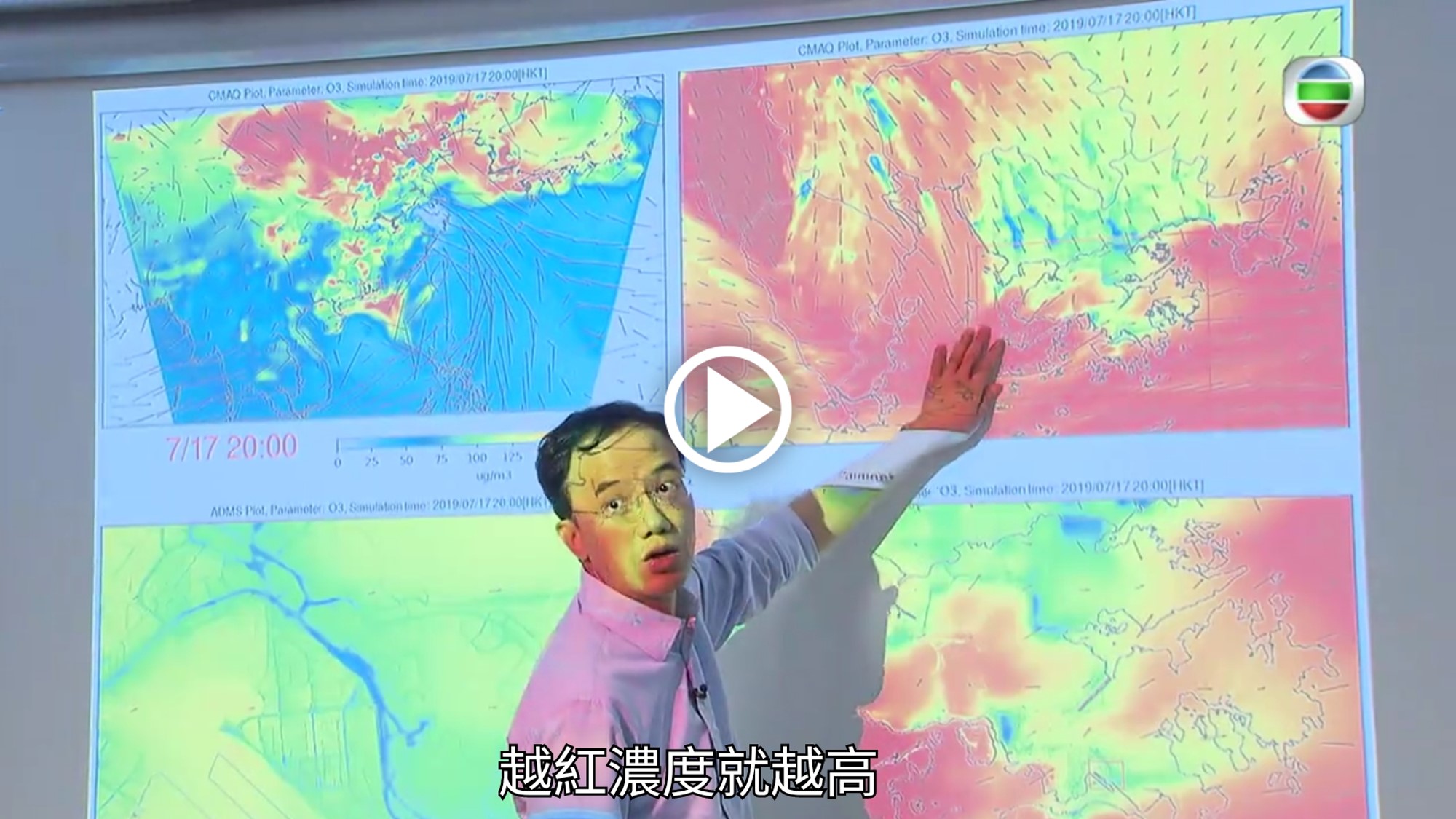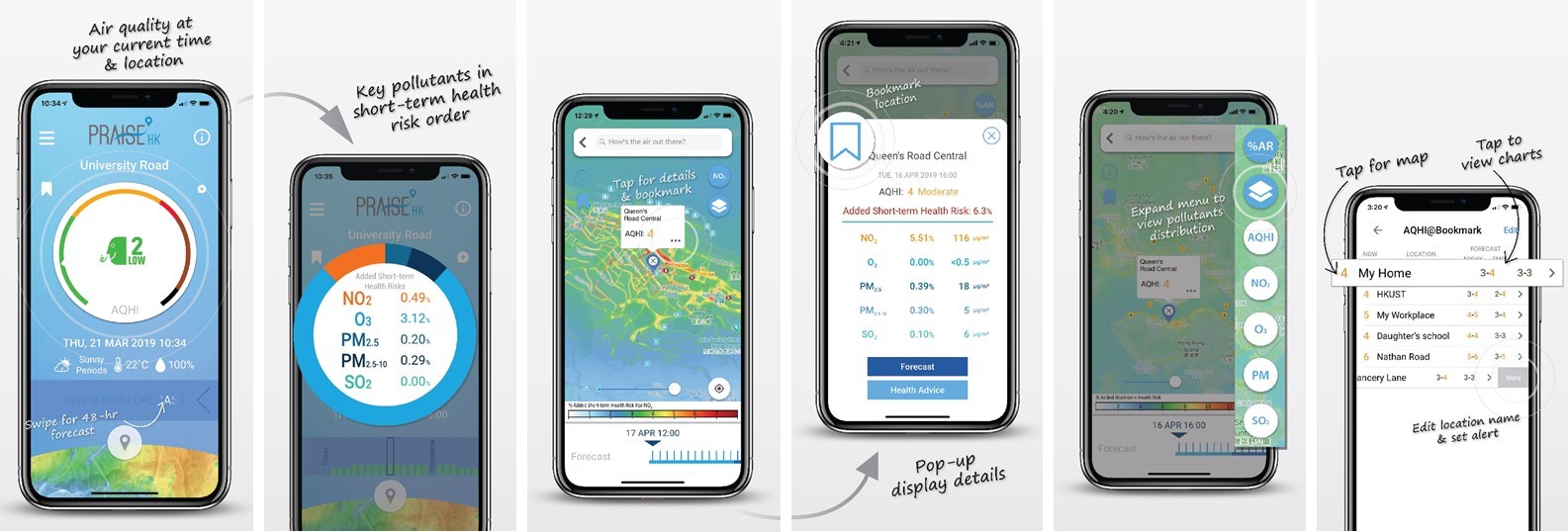Creating a High-Resolution Air Quality Forecasting System for Hong Kong
Summary of the impact
Air pollution is a major environmental risk to human health in Hong Kong and globally. Locally, it was associated with over 5,600 deaths in 2015 alone. Through a science-to-policy collaboration with government agencies, mathematician and atmospheric meteorologist Prof Jimmy Fung and his team in the HKUST Air Group used novel mathematical approaches to develop a regional fine-scale air-quality forecast system. This has achieved public policy, public health, and environmental impacts by:
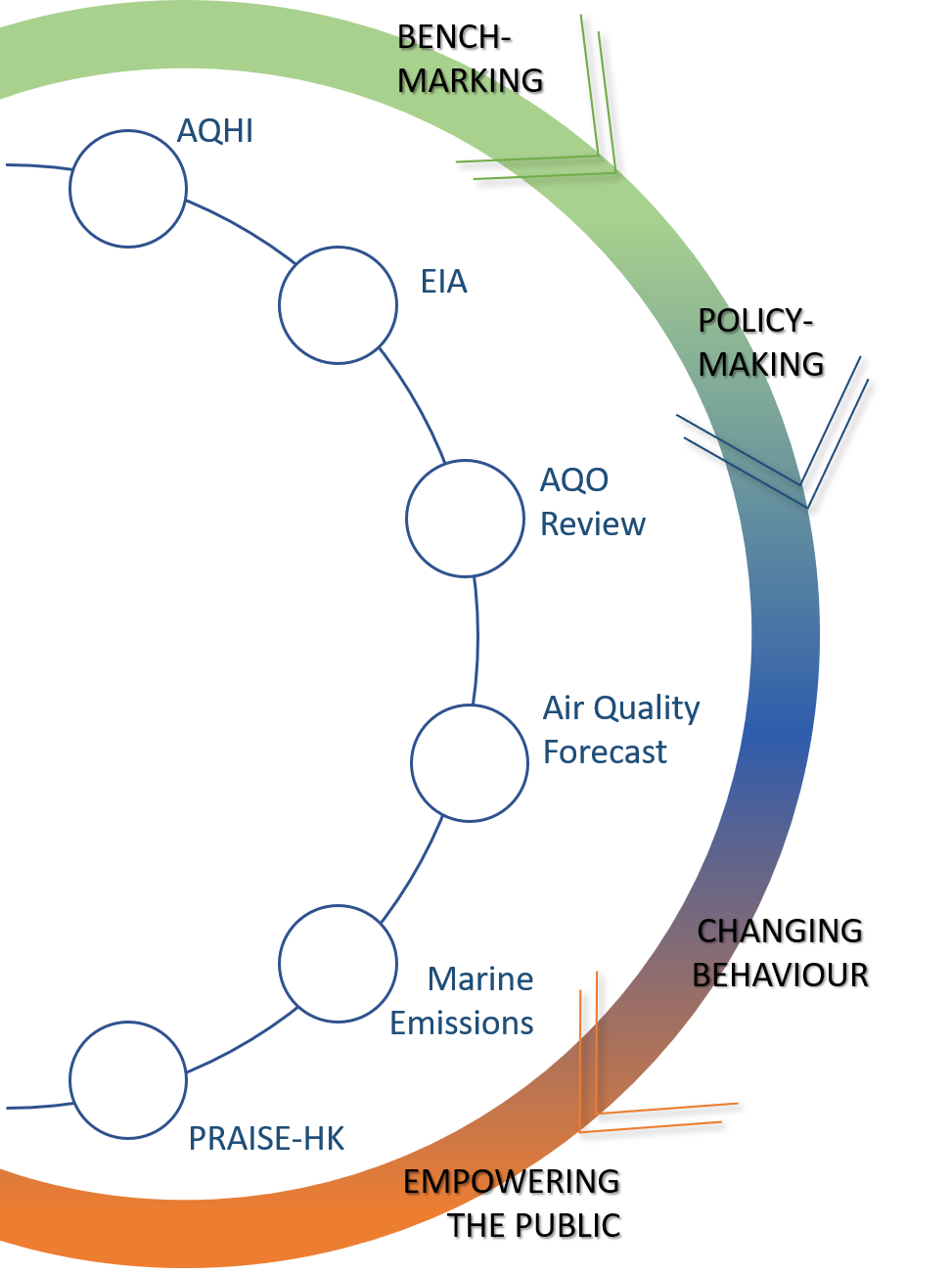
1. AQHI
Directly leading to improvements in the Air Quality Health Index (AQHI) forecasting system, now widely used as indicated by more than 95,000 downloads of Index-related apps;
2. EIA
Enhancing air quality measures used in Environmental Impact Assessments;
3. AQO Review
Informing Hong Kong policy-makers in relation to the 2018 Air Quality Objectives Review;
4. Forecasting capacity
Facilitating new forecasting of haze, benefiting the shipping and air transport sectors, and their safety;
5. Marine Emissions Policy
Informing new local and regional regulations to reduce marine emissions, and
6. Personal Exposure Management
Contributing to the 2019 launch of the globally innovative PRAISE-HK mobile app – a street-level air pollution measuring tool that empowers individuals to reduce their exposure to air pollutants and safeguard their health. Together, these developments to tackle air pollution have significant health and related economic benefits for the whole community in Hong Kong (population 7.4 million), another 12.5 million in Shenzhen, and millions more in wider regions of China.
Underpinning research
1992
Over the past 25 years, Prof Fung (joined HKUST: 1992) and his researchers have used novel mathematical approaches to develop high-resolution meteorological mesoscale models to study weather events around Hong Kong and southern China, and create the first university-based regional air quality forecast system in Asia. This has been conducted within the multidisciplinary HKUST Air Group, co-led by Prof Fung and civil and environmental engineer Prof Alexis Lau. The 15-member group provides atmospheric and air quality models for modeling, forecasting and monitoring air pollutants. It involves local and global collaborations (e.g. School of Architecture, Chinese University of Hong Kong [Prof E Ng]; University of Cambridge [Prof J Hunt]), government bodies (e.g. Environmental Protection Department, HKSAR; US National Center for Atmospheric Research), and NGOs and global agencies (e.g. Clean Air Network; World Health Organization), and utilizes HKUST’s leading research facilities and collaborative platforms, such as the Air Quality Research Supersite, Environmental Central Facility, and Atmospheric Research Center.
2000
From 2000, the Fung team, which specializes in mathematical modeling and applying computational fluid dynamics to air-quality modeling, made use of the Air Group’s pioneering, real-time mesoscale numerical weather prediction (NWP) system (est. 1996) to study wind fields associated with regional weather systems such as typhoons, thermally forced land-sea breeze circulation, and impact of urbanization on wind. All of these were confirmed to have a negative impact on regional air quality. Studies involved the development of novel mathematical approaches, including alternative mixing formulations to address the potential problem of turbulent mixing in pollutant transport [R1]; a local visibility regression formula to examine the relationship between the predicted aerosol mass concentration and light extinction coefficient over the Pearl River Delta region [R3]; and corroboration of the causality between urban morphometry and urban meteorology [R4]. These approaches enabled the team to develop simulations of wind fields for different meteorological conditions, and at different temporal and spatial scales [R2, R5] which have been used to drive their latest mesoscale air quality models (CMAQ/CAMx) used by the Environmental Protection Department (EPD) of the Hong Kong SAR Government, and Guangdong provincial government, as well as their fine-scale air quality model system CMAQ/ADMS for the PRAISE-HK project for street-level monitoring using a mobile app.
2008
In 2008, Fung’s team engaged in consultancy work with EPD to upgrade its regional air quality modeling system (PATH) to increase spatial resolution down to one kilometer. This involved better computation efficiency in Message Passing Interface (MPI) technology; a complex atmospheric chemistry scheme of particulate formation; and generating up-to-date land-use maps [R2, R3]. Through the PATH system, Fung’s team gained extensive experience in applying advanced regional atmospheric chemistry models (including CMAQ/CAMx) to study air quality over Hong Kong and the Pearl River Delta regions [R2, R3, R5] at neighborhood scales to help forecast air quality for the Air Quality Health Index (AQHI), and visibility. However, PATH’s 1km grid was still too coarse for more specific local air quality information. An alternative approach was developed to nest local-scale models within the regional models.
2014
So in 2014, Fung’s team, together with Cambridge Environment Research Consultants, began coupling the CMAQ regional forecast model and street-resolving ADMS-Urban modeling systems to create an integrated modeling system [R6]. This system could account for regional transport of pollutants driven by large-scale weather patterns and local emission sources, as well as small-scale effects created by urban morphology and traffic at individual street level, among others, to provide real-time air pollutant concentrations down to street scale.
2016
The concept of nesting ADMS-Urban in a regional air quality model without double-counting emissions is based on a separation of timescales to which each model is applied. In the immediate period after the release of a pollutant, concentration gradients are high, and a local model such as ADMS-Urban is most appropriate to capture the fine details of dispersion. However, as time passes, concentration gradients are reduced by mixing, and a gridded regional model can be used to represent pollutant transport and chemistry. The coupled modeling system was tested and validated using data from the EPD’s air quality monitoring station network. The system’s potential for more personalized information about air pollution levels in different city streets was then harnessed in the PRAISE-HK mobile app project, for individual monitoring by the general public (see Details of the Impact below).
Funding
NSFC-Guangdong Joint Funding (RMB2 million, 2011-13); Environmental Protection Department, HKSAR (total HK$5.8M, 2012-19); HSBC (HK$46M for PRAISE-HK, 2017-22).
Details of the impact
Prof Fung’s research has had significant and wide-reaching impact on (a) public policy; (b) the environment; (c) public understanding; and (d) public health through new systems to monitor air pollution and opportunities for mitigation. The beneficiaries cover the Hong Kong and wider Pearl River Delta region (population 60 million), and include policy-makers and government officials, environmental groups and businesses, air and sea traffic personnel, and the general public.
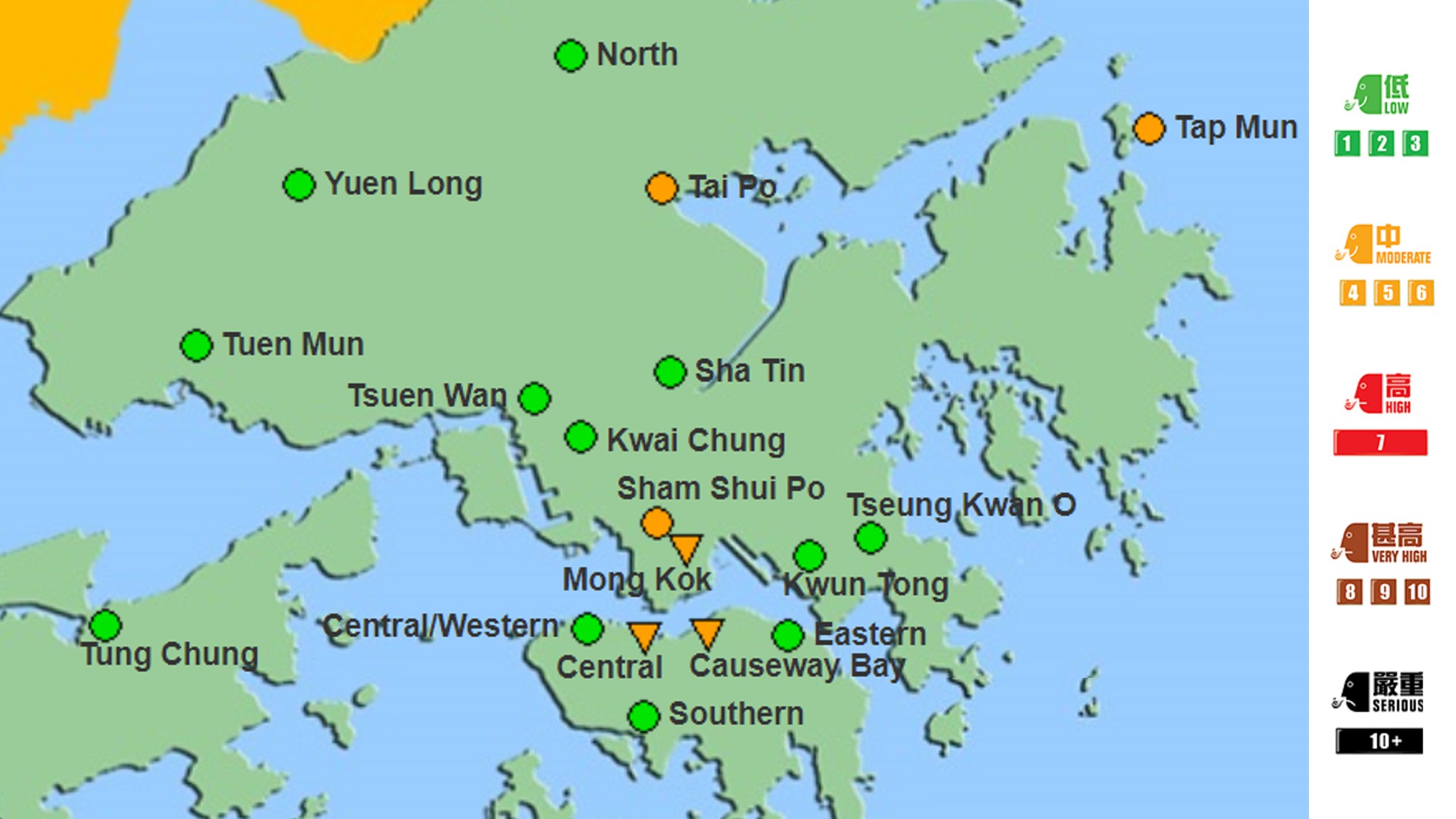
HKSAR Government webpage showing Hong Kong's AQHIs
(i) The Fung team’s role in upgrading the PATH real-time regional fine-scale (1-km resolution) air quality model enabled the Environmental Protection Department (EPD) of the HKSAR to improve its forecasting accuracy and launch the city’s daily "Air Quality Health Index" (AQHI), replacing the Air Pollution Index in December 2013. The new Index provides a public-facing scale (e.g. low to very high health risk) to help people understand the effect of air quality on their health, and the precautions they should take. This information is released through the AQHI website, hotline, and mobile apps, and to the media via the government’s News and Information System on an hourly basis. Dr Kenneth Leung, Head of the Air Science Group at EPD, testified:
“... the daily forecast … is based on our air quality model PATH which you helped us to improve based on your research works… we observed a very large usage of the AQHI from the general public daily”.
Since 2013, there have been over 95,000 downloads of index-related apps (as of 30 June, 2019), demonstrating how the research has contributed to meeting public demand for information to help people protect their health.

(ii) The team’s research, resulting in the PATH system upgrades in 2009 and 2016, increased the accuracy of air quality modeling used in governmental "Environmental Impact Assessments" (EIAs). Further upgrades were released in January 2016 as the default air quality model for EIAs for all large-scale projects in Hong Kong, with a long-term impact on public policy, the physical environment, practitioners in the construction industry, and public health. EPD’s Leung attested:
“Your participation in EPD’s PATH upgrade project assisted EPD in developing the latest PATH-2016 modeling system with a refined model grid size of 1km. Your work on the atmospheric boundary of the WRF model with improved land use parameters has greatly improved the accuracy of the modeled wind field. Your secondary organic aerosol (SOA) work on CMAQ has also helped our current air quality model within the PATH-2016 modeling system better forecast PM2.5 concentration.”
During the revision processes, Prof Fung contributed to policy-makers’ understanding through the sharing of his expert opinion with legislators, for example, the Legislative Council’s Panel on Environmental Affairs, Sub-committee on Issues Related to Air, Noise and Light Pollution (28 June, 2013), prompting legislators to call for greater transparency in air pollution modeling and its application in EIAs to be worked into the new system from December 2013 and included in subsequent Legislative Council policy discussions. Freeman Cheung, Senior Vice President of global infrastructure company AECOM, also affirmed the value of Prof Fung’s modeling for the major EIA projects that the firm was contracted by the government to undertake, such as Kai Tak Development scheme, using it in most of the firm’s EIA submissions.
(iii) The team’s role in upgrading the PATH-2016 air quality modeling system has had significant impact on policy and public health by being incorporated into the EPD’s 2018 Review of Air Quality Objectives. Prof Fung was also a government-appointed working group member and, in a subsequent consultancy with AECOM, project manager and air quality modeling team leader, responsible for all technical reports informing the new objectives. Work between 2016 and 2019 used data generated by PATH to assess air quality under different control scenarios and to explore the scope for further tightening the objectives. The strengthened air quality goals, released by government for public consultation in July 2019, are expected to enhance public health and individuals’ well-being for Hong Kong’s population (7.4 million) and bring HK$33 billion in economic benefits for Hong Kong, mostly from reduced hospital admissions and premature deaths averted, according to the proposed air quality objectives for 2025. EPD’s Leung affirmed the significance of Prof Fung’s contribution, stating that the PATH modeling work:
“provided a solid scientific foundation for reviewing the AQOs and to identify any possible scopes for tightening the AQOs with the ultimate objective of protecting public health. The successful completion of this study also demonstrates how a comprehensive engagement process can play a significant role in formulating strategies and plans to tighten the AQOs, which can serve as a good example for decision-makers to address the environmental issues with public concern”.
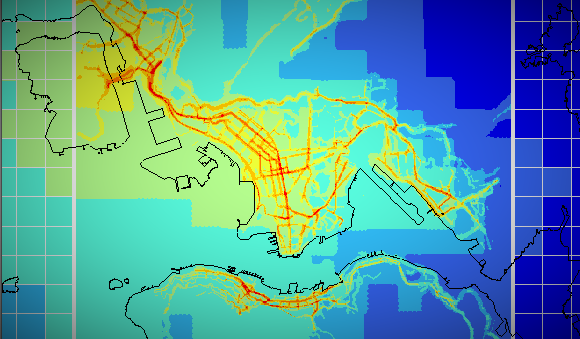
Air quality distribution in 1-km resolution (base map)
(iv) HKUST’s fine-scale (1 km) air quality forecast model has also had an impact on shipping and air transport safety; the data generated is used by the Central Forecasting Office and Airport Meteorological Office of the Hong Kong Observatory, to deduce how visibility is affected by the haze. This has been used since 2013 by Hong Kong International Airport to enhance flight scheduling, and assists more than 430 commercial vessels daily travel safely in Hong Kong waters. Senior Scientific Officer PW Chan at the Observatory confirmed in a supporting letter that:
“the real-time products of your system is a source of useful forecasting reference”
... for the two offices “in formulating visibility-related weather forecasts associated with hazy conditions” broadcast to the public via the Observatory’s website.
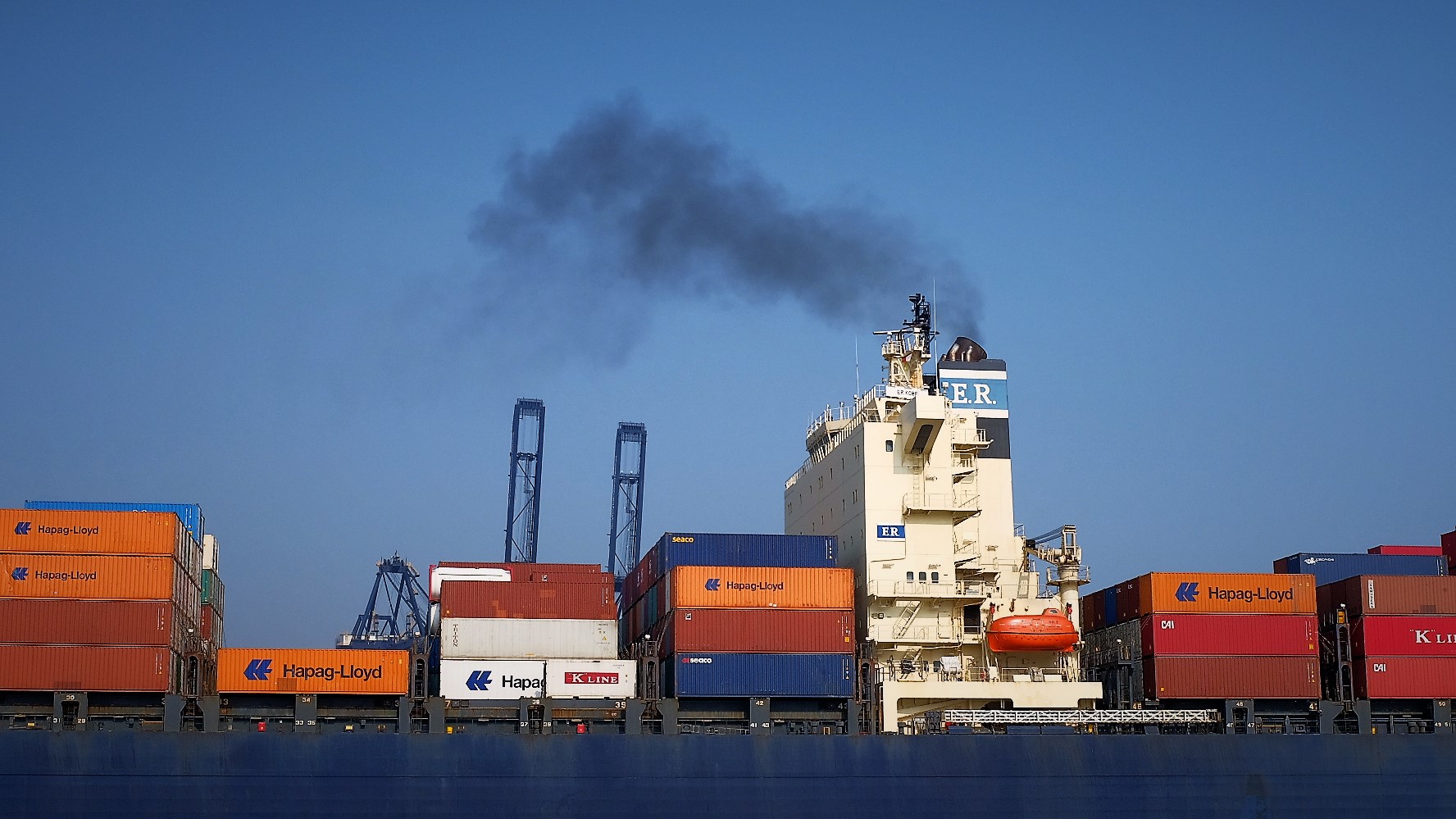
(v) HKUST’s air pollution monitoring tools have informed a feasibility study and regulations to reduce marine emissions in Hong Kong and nearby mainland coastal regions, which has impacted public policy, public health, and the environment. Their consultation was used to inform the Ocean-Going Vessels Fuel at Berth regulation, enforced since July 2015 in Hong Kong – the first marine fuel control regulation for ocean-going vessels in Asia – and succeeded by the Air Pollution Control (Fuel for Vessels) Regulation from January 2019. The report was shared with mainland authorities from January 2013. Similar regulations were adopted nationally, for China’s coastal ports, followed by the establishment of domestic emission control areas in coastal waters that came into force in a January 2019 regulation as an outcome of the work of the Shenzhen-Hong Kong Office for Marine Emissions and Control, benefiting both communities (population around 20 million) and the environment. Prof Fung and his colleagues provide expert advice to this office.

(Schematic diagram showing HKUST-IENV's work on shaping ship emissions control policy)
(vi) The team’s air quality forecasting modeling has been incorporated into HKUST’s innovative mobile app PRAISE-HK, The app, launched in June 2019 and supported by HK$46M funding from HSBC, enables the public to protect their health by knowing and controlling the levels of air pollution they are exposed to, in real-time and wherever they are in the city. The app has been welcomed by government officials, health experts, and the business sector, including the Secretary for the Environment of the HKSAR. Wing-Kai Chan, chairman, Hong Kong Asthma Society, affirmed:
“Some of our members are already using PRAISE-HK in their daily lives as a preventive measure”
... and welcomed the knowledge they gained from Prof Fung’s workshops on how to reduce pollution exposure while allergy consultant Dr. Tak-Hong Lee, former president, Hong Kong Institute of Allergy, attested to the positive feedback from patients able to reduce exposure on high pollution days predicted by the app. Since launch, PRAISE-HK has recorded over 6,000 downloads and 25 media reports, including TV, print, and online news, reaching audiences in the millions.

